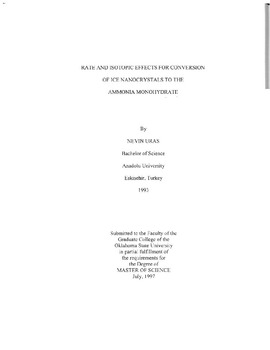| dc.description.abstract | This thesis considers the formation of the monohydrate of ammonia in view of the mechanism and rate. The usage of ice nanocrystals, as the sample for Fourier Transform Infrared (FT-IR) Spectroscopy, is also described as related to this hydrate formation. We can find the potential applications of this study in atmospheric chemistry since the ice is the basic component in the atmosphere of the earth and planets. In addition to an existence of H20 ice, small molecules such as CH4, N2, CO2 and NH3 were found in planets, comets and interstellar particles. Interaction of these molecules with the ice causes different effects in the atmosphere. Since knowledge about the atmosphere of the earth and planets is gained through direct observations, laboratory and theoretical studies that supplement the observations are used to explain the planetary chemical processes and the fundamental constants of these processes, such as rate constants, thermodynamic data, spectroscopic constants and so on. From direct observations, supported by the laboratory and theoretical studies,natural events and the composition of the planets and their atmospheres can be predicted. Lewis made a model for Jupiter's clouds and studied the thermodynamic properties. He showed that solid phases of H20 and NH3 are important components of the atmosphere at high altitudes at which the temperature is below a few hundred Kelvin. The thermodynamic studies of the NH3-H20 system showed that the hydrate forms of ammonia may be found under the clouds ofNH3. The same model was assumed for satellites of the outer planets by Lewis.3 He showed that solid H20, NH3 and its hydrates condense below 250 K. To our knowledge, there are no kinetic data about the formation of ammonia monohydrate. For this reason, the rate of conversion of ice nanocrystals to the ammonia monohydrate was studied under laboratory conditions. To further understand the nature of this conversion, H20 ice was replaced by 0 20 ice OF NH3 by NO). From this point, we have also tried to observe isotopic effects on the reaction rate for this conversion. | |
